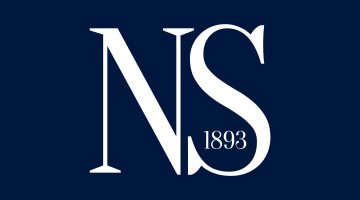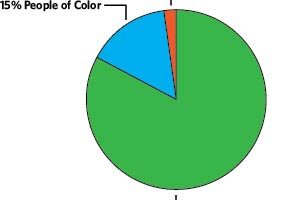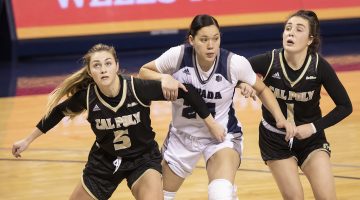
Editor’s note: Over the next several weeks, The Nevada Sagebrush Sports Desk will be breaking down the Nevada Athletics budget into a series of reports. This first article will act as a general debrief over the Nevada Athletics’ self-reported expenses for each sport. This will provide a foundation for future articles in the series.
Nevada Athletics released a summary of its annual EADA budget report for the 2018-19 fiscal year last week.
The budget, totaling over $43.4 million, goes to funding the 15 NCAA sanctioned sports at the University of Nevada, Reno. The individual budget for each sport ranges from well over $10 million to the lowest sport, operating at a cost of less than $300,000 per year.
Each team’s individual budget goes to cover the costs of financial aid, coaches’ salaries and game-day expenses.
Every sport on campus has a single head coach. The number of assistant coaches ranges depending on the sport. Some sports have no assistant coaches while others have upwards of 10.
Also included in the report is the number of participating athletes in each program. According to the budget, there was just under 400 student-athletes total at the university within the last fiscal year.
The report details the total expenses for each sport. Below is a brief summary of each sport’s expenses.
All references to the EADA Report are referred to as the budget and all salary numbers for coaching staff members, was gathered via TransparentNevada.
Football
Nevada football had the largest budget of any sport on campus, taking up 39.9 percent of the budget with over $10.7 million in expenses. They also have the largest coaching staff and student-athlete roster according to the budget—123 student-athletes and 10 assistant coaches.
Part of the $10.7 million in expenses goes to paying head coach, Jay Norvell. Norvell’s base salary sits at $495,833.38. Not included as part of his regular pay is another $219,247.61 in expenditures marked as “Other pay and Total benefits.”
According to the budget, the average head coach of a men’s program at Nevada makes $349,737, meaning Norvell is paid above the average. The average head coach of a women’s program is paid $91,704.
Men’s basketball
Men’s basketball is the next largest expenditure on the budget next to football. Their total budget sat at $4.7 million, or 17.5 percent of the total budget.
Between football and men’s basketball, the two sports make up over half of the total athletic budget at Nevada.
However, it should be noted that these numbers reflect the old coaching staff for men’s basketball. Former head coach, Eric Musselman, left the Pack this past Spring, choosing to forego the remainder of his contract with Nevada for an opportunity to coach at the University of Arkansas.
Before leaving the Wolf Pack for the Razorbacks, Mussleman was being paid over a million dollars a year to lead the men’s program.
As part of Musselman’s previous coaching staff, the former head coach had three full-time assistant coaches. The men’s team also had 17 student-athletes on their roster.
Women’s basketball
Women’s basketball was the most heavily funded women’s program on campus in the last fiscal year. According to the report, they are allocated $2.1 million dollars from the total expense budget. This makes up 7.9 percent of the total budget.
The $2.1 million in expenses went to funding the 13 student-athletes that were on the roster and the three full-time assistant coaches that head coach, Amada Levens, had on staff.
As for Levens herself, her salary sits at $190,266.68 in regular pay. An additional $62,889.62 in ‘Other pay and Total Benefits’ rounds out her salary.
The average salary for her coaches, all of whom are women, are paid an average of $54,652. This, compared to the average salary of an assistant coach on one of the men’s teams, which pays an average of $123,692 per the report.
Baseball
The Nevada baseball team had a total budget of over $1.6 million, making it the fourth-largest budget on campus per the budget. In total, this accounts for 6.2 percent of the total expense budget.
Led by head coach, T.J. Bruce, Wolf Pack baseball employes two assistant coaches while fielding 34 student-athletes. This makes Nevada baseball the second-largest men’s sport on campus, behind only football.
Bruce’s total salary and benefits package is quoted at $197,414.03.
Track and field/Cross country
Sitting just behind baseball is the combined budgets of the Track and field program and the women’s cross country team. The two programs share a budget of over $1.5 million—5.8 percent of the total budget—according to the budget.
After combining the rosters of these two programs, this singular program has the second-largest student-athlete roster behind only football.
According to the budget, the programs have two assistant coaches between the programs to assist head cross country coach, Kirk Elias, and head track and field coach, Shantel Twiggs.
Between the two head coaches, they are paid $185,237.35, with Twiggs getting $106,961.67 of that combined salary.
Swim and dive
The swim and dive program takes up 4.1 percent of the budget or $1.1 million. These funds go to supporting the 17 women of the student-athlete roster.
Also on the roster is head swim and dive coach, Brendon Bray, whose total pay and benefits sit at $98,592.67. Head diving coach Jian Li You total benefits and pay is set at $90,371.17.
The EADA budget however only lists one head coach for the program, as it counts both sports as a singular entity. It’s currently unclear which head coach is considered an assistant coach by the budget.
Soccer
With a budget of $1.086 million, women’s soccer is allocated 4 percent of the total budget. The just over one million dollars go to supporting the 32 student-athletes, head coach, Erin Otagaki, and two assistant coaches.
Otagaki’s total pay and benefits package is currently quoted at $96,259.69. This is a decrease over her 2017 total pay and benefits, that totaled out at $100,678.70.
Softball
The last program that has a budget of over $1 million, is Nevada softball. The women’s program was allotted $1.039 million or 3.9 percent of the total budget.
Led by head coach Josh Taylor, the program fields 26 student-athletes and employes two assistant coaches within the program. Taylor currently makes $99,519.67 in total pay and benefits, a slight increase over last year.
Volleyball
Of the six programs that have budgets under a million dollars, Volleyball has the second-largest roster size, second only to rifle. However, they are also the closest to a million-dollar budget by a fairly wide margin.
To support Volleyball’s 16 person roster, they are allocated by the budget just over $941,314. The equals out to 3.5 percent of the total budget.
The program also employes head coach, Lee Nelson, and a single assistant coach.
Nelson earns a total of $152,764.46 between his total pay and benefits. Nelson’s pays has increased steadily since being brought on to lead the program in 2015. When he became the head coach of the volleyball program, Nelson’s total salary and benefits sat at $111,236.54.
Men’s and women’s tennis
Men’s and women’s tennis both receive different expense budgets according to the EADA report.
The women’s budget is just over $150,000 more than their male counterparts and has one less student-athlete on their roster. The women’s team fields eight student-athletes, while the men’s team has nine.
Women’s tennis is allocated nearly $586,973, whereas the men’s program has a budget of $435,597. Percentage-wise, this puts the women’s program at 2.1 percent of the total budget and the men’s program at 1.6 percent.
According to the budget, neither team has an assistant coach but has each has a separate head coach. Men’s coach, Sylvain Malroux, is compensated $99,208.76 in total pay and benefits, while his counterpart on the women’s team, Guillaume Tonelli, receives $84,037.61.
It should be noted that according to the budget, neither of these programs have official assistant coaches, but the Nevada Athletics website does list one for each. As to why assistant coaches would not have to be recorded on the budget document is currently unclear.
However, men’s and women’s tennis isn’t the only sport where this occurs, as multiple others also fall under this category.
Men’s and women’s golf
Similarly to men’s and women’s tennis, golf is also split into two separate budgets. The women also have a slightly higher budget than their male colleagues.
However, unlike the golf programs, the women’s team coach is paid higher than the men’s coach. Head coach, Kathleen Takaishi, is paid $84,104.77 between her total pay and benefits, whereas the men’s head coach, Jacob Wilner, is compensated $78,954.67 overall.
The women’s golf total budget is quoted at $484,740, with men’s golf close behind at $443,405. The total impact these two programs have on the budget is 1.8 percent and 1.7 percent respectively. Women’s golf fielded eight athletes, whereas the men’s team had seven.
The last major difference between the two programs once again deals with the coaching staff. The women’s team has no assistant coaches, according to the report, whereas the men’s program has one.
Rifle
The final program listed on the budget is also the smallest and by a wide margin.
Rifle, which took up less than one percent of the total expense funds, had a budget last year of $259,017 to support its 18 athletes. This co-ed sport, consisting of six men and 12 women, was terminated as a program following their season this past Spring. It was the only NCAA co-ed sport on campus.
Leading the program as head coach, was Fred Harvey, who was at his position for more than two decades. His salary was listed at $8,333 according to the budget report.
Not Allocated funds
Although the budget is listed to be at $43.4 million, the report only allocates were just over $27.1 million of the budget is going. $27.1 million is the money being spent directly on the sports programs.
The other $16.3 million is listed as “Not Allocated by Gender/Sport.”
The report defines this term as such, “Expenses not attributable to a particular sport or sports.” It is currently unclear how this category of expenses is being spent.
It is currently unclear how that money is being spent specifically.
| Name of sport: | Budget: | Number of Participants: | Number of Asst. Coaches: | Total percentage of the budget: |
| Football | $10,710,232 | 123 | 10 | 39.9% |
| Men’s Basketball | $4,706,010 | 17 | 3 | 17% |
| Women’s Basketball | $2,115,279 | 13 | 3 | 7.9% |
| Baseball | $1,669,608 | 34 | 2 | 6.2% |
| Softball | $1,039,747 | 26 | 2 | 3.9% |
| Track and Field/Cross Country | $1,544,150 | 113 | 2 | 5.8% |
| Swim and Dive | $1,107,570 | 17 | 2 | 4.1% |
| Soccer | $1,086,908 | 32 | 2 | 4.0% |
| Volleyball | $941,314 | 16 | 1 | 3.5% |
| Women’s Tennis | $586,973 | 8 | 0 | 2.1% |
| Men’s Tennis | $435,597 | 9 | 0 | 1.6% |
| Women’s Golf | $484,740 | 8 | 0 | 1.8% |
| Men’s Golf | $443,405 | 7 | 1 | 1.7% |
| Rifle | $259,017 | 18 | 0 | Less than 1% |
Editor’s note: Contributing to the budget analysis portion of this story were staff writers Isaiah Burrows, Matt Hanifan, Madeleine Chinery, Jory Richardson and F. Evans.
Ryan Freeberg can be reached at rfreeberg@sagebrush.unr.edu and on Twitter @SagebrushSports











